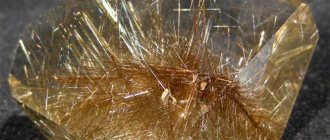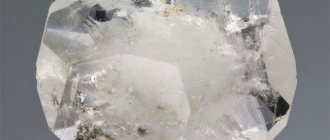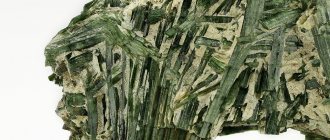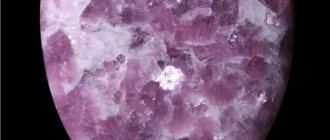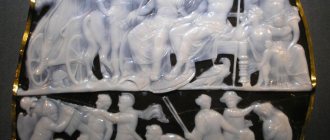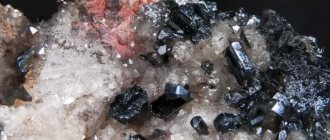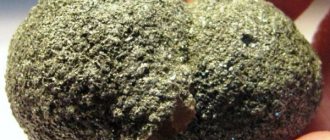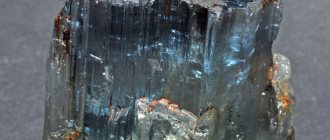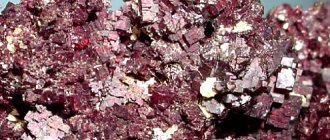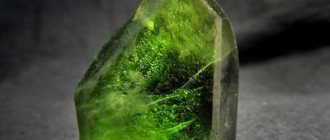| Category | Carbonates (minerals) |
| Title in English | Smithsonite |
| Formula | ZnCO3 |
| Group | Carbonate group |
| Color | White, Blue, Yellow, Green, Grey, Pink, Purple, Brown |
| Stroke color | White |
| Shine | Glass |
| Transparency | Translucent |
| singonia | Trigonal |
| Hardness | 4 — 4,5 |
| Cleavage | Perfect |
| Density, g/cm³ | 4,4 — 4,5 |
| Kink | Stepped |
| origin of name | When this mineral was discovered, it could not be distinguished from hemimorphite. Therefore, both stones were called “calamine”. Later, British mineralogist James Smithson |
Smithsonite, also known as zinc spar, is a common carbonate mineral. The stone got its name from the mineralogist and chemist J. Smithson (Great Britain), who discovered its difference from hemimorphites. The green-colored subspecies of smithsonite is found under the name “herrerite,” and the green-blue subspecies is called “bonamite.” The gem is very popular among collectors, specimens with a “fiery” glow are especially in demand, as well as in jewelry.
History and origin
Many people associate Smithsonite with the US Smithsonian Institution, and for good reason. After all, the name of a scientific institution, just like the name of a mineral, originates from one source - the name of the English chemist and mineralogist James Smithson. Being the illegitimate son of a duke, Smithson did not inherit the title and corresponding position in aristocratic society.
However, the mother provided her son with a remarkable fortune. The will of the dying scientist stated that all his capital would be inherited by a blood relative, but only if he had an heir by the end of his life. If this condition is not met, the fortune will be bequeathed to the Americans for the needs of science and education.
Thus, in 1846, the Smithsonian Institution of the United States of America was founded, consisting of 35 institutions, including museums. This event was made possible by Smithson's legacy, amounting to approximately £100,000.
Cross section of a Smithsonite crystal from New Mexico
Until the beginning of the 19th century, smithsonite, like hemimorphite, belonged to the calamine group. James Smithson succeeded in isolating zinc carbonate as an independent mineral in 1803. The scientist examined and described the nugget in detail, proving its difference from calamine.
The name “smithsonite” entered science thanks to the French geologist Francois Beudan in 1832, after Smithson’s death. People also use such names for the stone as “bonamite” or “zinc spar”.
Smithsonite is a common secondary mineral that forms in zones of sulfide oxidation. Surface waters rich in zinc salts, affecting limestones and dolomites, also take part in the formation.
Smithsonite history
The first scientific description of a new, previously unknown mineral was given by the scientist Beudant at the beginning of the 19th century.
But then Smithsonite was not distinguished from hemimorphite, and both stones were classified as the same species called calamine. Later, the mineral scientist J. Smithson (thanks to whose financial assistance the world-famous Smithsonian Institution was created in the United States today) discovered the differences between these two minerals, gave them separate descriptions, and one of them was subsequently named after its discoverer - smithsonite. The mineral and its varieties are also known under other names, including “zinc spar”, “herrerite”, “bonamite”.
Deposits and production
Smithsonite is found everywhere. Each deposit is famous for its unique specimens.
The following countries are considered major suppliers of smithsonite:
- Australia.
- USA.
- Island of Sardinia (Italy).
- Namibia.
- Morocco.
- Zambia.
Significant deposits are also located in the territories of Greek Attica, Spain, Germany, Mexico, Kazakhstan, and Poland. In Russia, the mineral is found in the south of the Urals, Altai, Transbaikalia, as well as the Dalnegorsk deposit (Primorsky Territory).
Origin and location
Smithsonite is a typical mineral of the lower horizons of the oxidation zone of lead-zinc sulfide deposits occurring in limestones. Sometimes it forms significant deposits, mainly in the recumbent side of ore bodies. If the primary ores themselves contain a lot of calcite, then smithsonite is also found in the upper parts of oxidation zones in association with zinc silicates, galena and sometimes sphalerite remains. Its formation occurs metasomatically through the reaction of exchange decomposition of readily soluble zinc sulfate with calcite:
ZnSO4 + CaCO3 + 2H2O = ZnCO3 + CaSO4. 2H2O.
This reaction, in all likelihood, occurs after the excess of free sulfuric acid in solutions is neutralized by reaction with the same calcite. If ferrous sulfate is involved in the solutions, which is possible only in the lower horizons of the oxidation zone, then smithsonite contains Fe[CO3] as an isomorphic impurity, sometimes in significant quantities (monheimite). Ferrous smithsonite , when exposed to an oxidizing environment, decomposes with the release of iron hydroxides, and zinc in the form of smithsonite, which no longer contains iron, can be redeposited in other places. Smithsonite masses, densely pigmented with iron hydroxides, are not much different in appearance from ordinary limonite porous or cavernous masses and therefore are often easily missed. The presence of smithsonite in them can be determined using a blowpipe or in thin sections under a microscope.
Physical properties
Smithsonite is a brittle zinc carbonate that is susceptible to acid attack but is heavy and hard. It dissolves completely in hydrochloric acid. In ultraviolet light, green or red fluorescence is observed.
| Formula | ZnCO3 |
| Color | Light green, blue, pink |
| Stroke color | White |
| Shine | Pearl |
| Transparency | Translucent to opaque |
| Hardness | 4 — 5 |
| Cleavage | Perfect |
| Kink | Uneven; fragile |
| Density | 4.3 - 4.5 g/cm³ |
| singonia | Trigonal |
| Refractive index | 1,621 — 1,849 |
The colorless mineral is unremarkable, more like table salt. However, impurities of calcium, magnesium, cobalt, iron, manganese or cadmium give the gem a variety of shades. Forms of formation: nodules, deposits, spherulites. There are cortical layers, stalactites, dense or granular masses.
Crystal formations are very rare and therefore quite valuable to collectors.
Chemical composition
Zinc oxide (ZnO) 64.8% (Zn 52%), carbon dioxide (CO2) 35.2%, iron, manganese, less often calcium, magnesium, sometimes cobalt, and occasionally cadmium are often present as impurities.
Complete isomorphic miscibility between
ZnCO3 and CoCO3 and ZnCO3 and CdCO3 have not been established, but Co and Cd can replace Zn.
Varieties
Ferrous (monheimite, capnite) and copper (gerrerite) varieties are known, as well as those containing Pb, Mn, Mg and Ca.
Crystallographic characteristics
Syngony. Trigonal.
Symmetry class. Ditrigonal-scalenohedral - 3 t. With. L363L23PC. Etc. gr. R3c (D63d). a0 = 4.65; c0 = 14.95.
agn - 5.88 A, a = 103°30′, Z = 4 for a cell of a fused rhombohedron, a'rh = 5.63 A, a = 48°20\ Z = 2 for a unit cell; , Z = 6 for a hexagonal cell.
Crystal structure. Similar to the structure of calcite (lime spar).
The main forms: rhombohedrons {101–1} and {401–1}, scalenohedron {213–1}, less commonly pinacoid {0001}, rhombohedrons {011–2}, {022–1} and prisms {112–0). The edges are often curved and rough.
Types of stone
The variety of impurities led to the formation of the most beautiful multi-colored specimens of the stone.
This is how Smithsonite happens:
- red;
- white;
- pink;
- blue;
- yellow;
- orange;
- brownish-brown;
- green;
- purple.
Some of the varieties have their own names. For example, blue or greenish-blue stone is called “bonamite”. This shade of sea wave gives the mineral an admixture of copper.
The name "bonamite" comes from the French "bon ami", which translates as "good friend". But the interesting thing is that the name was chosen for a reason - the last name of the owner of the mine where these extraordinary Smithsonites lay sounded like “Goodfriend,” that is, “good friend.” But the most beautiful version of the name turned out to be French, so it came into use.
“Warrenites” are called smithsonites, which, thanks to cobalt, are endowed with a beautiful pink color. Sometimes copper is added to cobalt impurities, and then the varrenites turn purple.
Pink Smithsonite
Brown-yellow or brownish-brown gems are called “ferrosmithsonites,” which indicates the presence of iron in the composition of the nugget. Although there are analogues of this name - “kapnit”, “monheimit”. But the bright yellow stones are called by a rather unusual name - “turkey ore.” The mineral owes its sunny color to inclusions of cadmium.
Another interesting sample, mined in the US state of New Mexico, is called “Aztec stone”. This gem is a mixture of bright blue smithsonite with white hemimorphite, lying in the depths of the Earth along with beautiful large specimens of bonamite.
The green variety is sometimes called herrerite, and the blue-green variety is sometimes called bonamite.
Prices for Smithsonite products
Smithsonite usually occurs as large rough aggregates or cluster-shaped aggregates. The cost of such a copy, depending on the color and size, ranges from 60 to 80 dollars. As for jewelry, they are all much more expensive due to the rarity and complexity of processing this mineral.
Medicinal properties
The range of medicinal properties of smithsonite is very wide, but the color of the mineral is taken into account. So, depending on the shade and impurities that are in the nugget, there are practically no insoluble health problems for Smithsonite:
- The green gem is responsible for immunity, as well as for the rehabilitation of the body after suffering serious illnesses, including oncology. Green smithsonite also facilitates the birth process.
- The pink stone is responsible for the normal functioning of several organs and systems at the same time - the intestines, heart, blood vessels, genitourinary system, respiratory organs. This nugget is used to heal trophic ulcers, as well as to relieve muscle pain.
- The yellow mineral copes with diseases such as sinusitis or asthma.
- Zinc contained in Smithsonites is responsible for the “purity” of the body, removing toxins from it and cleansing the skin. In addition, the nugget helps in the treatment of skin cancer, eliminates headaches and dizziness, helps cope with hair loss, and is used to treat diabetes.
In general, Smithsonites, regardless of color, are widely used by lithotherapists to restore sexual function in both men and women. For women, the stone helps regulate the menstrual cycle and cope with periodic pain. The stone also improves the activity of the ovaries, which, in turn, eliminates a number of problems with conception.
In addition, Smithsonites are also beneficial for the nervous system. Any of the stones helps relieve nervous tension, recover from stress, heal and prevent nervous breakdowns. Other lithotherapeutic areas include alcoholism, osteoporosis, problems with the elasticity of muscles and veins. Sometimes the mineral is used in the manufacture of homeopathic remedies.
Therapeutic effect
Smithsonite from Namibia 2.6x2.5x1.6 cm
The healing properties of smithsonite are provided by the impurities and color of the mineral:
- Yellow stones improve the functioning of the respiratory system, help overcome insomnia and anxiety, and promote the functioning of the reproductive system and wound healing.
- Blue gems have a beneficial effect on the thyroid gland, kidneys, liver, and heart.
- Green smithsonites help improve immunity, normalize emotional state and blood pressure.
- Red and pink stones will relieve melancholy and despondency and increase efficiency. Purple crystals improve tissue regeneration, so they are recommended to be worn after operations.
Zinc, which is part of smithsonite, has a beneficial effect on the skin. It helps get rid of dizziness and headaches, and prevents hair loss. The positive effect of the stone on the body during the treatment of cancer has been noticed.
Magic properties
Magically, Smithsonite is also versatile and powerful.
Esotericists note the following properties:
- The stone attracts success and luck, and drives away fears.
- Helps a person get rid of timidity and uncertainty, thereby promoting self-affirmation and self-realization in society.
- Harmonizes man with nature.
- Strengthens the desire to learn new things, which makes Smithsonite an excellent talisman for schoolchildren and students.
- Promotes the development of all levels of consciousness, connecting its emotional part with the intellectual component.
Smithsonite is suitable for meditation, as it relaxes and clears the mind, calms and promotes concentration of thoughts. The nugget sharpens the sixth sense - intuition, especially among doctors and traditional healers. It is believed that in the process of meditation with the participation of the mineral, the doctor is able to learn the techniques of ancient healers.
Interesting facts about Smithsonite:
James Smithson was an illegitimate child, but received a large fortune from his mother. This allowed him to engage in science and become a world famous mineralogist. The discovery of the mineral smithsonite, which was later named in his honor, also belonged to the scientist. It is interesting that the magical properties of the stone are similar to those qualities that Smithson himself was endowed with. Thus, thanks to his generous bequest, the Smithsonian Institution was created in the United States, which consists of 35 scientific institutions that are designed to be a source of light and knowledge for all humanity.
How to wear and care
Smithsonite is a brittle mineral with a low hardness index.
Therefore, the attitude towards products made from this stone should be as careful as possible:
- Store in soft fabric bags or boxes with soft walls separately from other products and minerals, away from moisture and sun.
- Eliminate any mechanical influences - shocks, falls, friction.
- Avoid exposure to household chemicals and any products that can damage the stone.
To clean the nugget, a warm soapy solution and a soft cloth are enough. After the procedure, the gem should be thoroughly dried.
Chemical properties
Behavior in acids. Smithsonite dissolves in acids relatively easily, sometimes with effervescence (especially earthy varieties).
Calcined, after wetting with a solution of Co[NO3]2 and secondary calcination in an oxidizing flame, turns green.
Diagnostic signs
Similar minerals . Calcite, phosphorite, dolomite, calamine.
In crusts and cryptocrystalline masses, it is not always easy to distinguish opal, zinc silicates (hemimorphite, willemite), etc. from a number of minerals found in paragenesis with it. Due to its light color, it is not immediately noticeable among limestones. You always have to resort to studying its behavior in front of the blowpipe and chemical reactions. Of the secondary properties, smithsonite is characterized by increased specific gravity and hardness (5).
Associated minerals. Calcite, dolomite, opal, calamine (silicon-zinc ore), sphalerite, malachite, azurite, ceruseite, limonite and other minerals.
Astrological compatibility
Astrologers classify the mineral as a universal stone. Therefore, there are no restrictions on the zodiac sign. When choosing a talisman, it is advised to rely on the magical properties of the stone.
Some will feel powerful support, but for others this gem will become only a ghostly helper:
- Taurus is one of the signs that is impressed by Smithsonite, especially green. The talisman will attract Taurus people to meet influential people, prosperity, and good luck. Just be careful - there will be too many envious people with negative energy around, and the stone is not one of those that absorbs such negativity.
- Red-colored amulets are suitable for Gemini. For them, the nugget will provide a surge of energy to achieve what they want, as well as for fights with ill-wishers. The stone will have to be removed from time to time so as not to become oversaturated with its energy.
- Aries will experience maximum performance if they wear Smithsonite on their left hand. This will have a positive impact on career growth or profits when running your own business.
- Leo businessmen are recommended to take a purple talisman to fateful business meetings. Smithsonite will help you focus on the details and nuances of negotiations.
- Scorpios will receive the help of yellow minerals. A stone of any shape and cut will not allow Scorpio to stray from the right path at turning points.
- For Sagittarius, Smithsonite is a talisman of family happiness. With such a talisman, Sagittarius is not afraid of troubles, betrayal or betrayal - the home will always be filled with mutual understanding, love, devotion and friendship.
- Pisces will feel internal changes with a stone talisman. The positive qualities of Pisces - responsiveness, decency, goodwill - will increase significantly. And in addition to this, perseverance, exactingness, and determination will be added.
- Aquarians will build strong and long-lasting relationships if they give a woman a gift made of Smithsonite. Life together promises to be as smooth as water, without misunderstandings and embarrassments.
- It is useful for Capricorns to have such a talisman, better than blue shades. The stone will become a lifelong assistant of this Zodiac if a person listens carefully to its prompts. The amulet will not allow ill-wishers to break Capricorn, lure him to the dark side, commit deception, betrayal or any action contrary to his principles.
Cancers, Libras and Virgos will feel only a minimal impact of Smithsonite in their lives or not at all. For Cancers, the stone is more suitable as a decoration, Libra will feel peace from contemplating the mineral, and Virgos will receive hints in love affairs if they themselves do not sit with their hands folded.
Smithsonite Applications
Smithsonite is used relatively rarely as a jewelry stone, as it is fragile and soft.
Usually only large transparent specimens of gemstones are processed and cut into cabochons, which are then used as inserts in various jewelry. Much more often, Smithsonite is used for inlaying metal and wooden products and for inserts into stained glass windows. Thin plates are cut out from massive aggregates of the mineral. This is done parallel to the growth axes so that the fragility of the stone does not interfere, and its beauty is revealed to the maximum.
In industry, Smithsonite serves as a source of non-ferrous metals: zinc, cobalt and copper.
Interesting Facts
Rainbow Smithsonites are found in nature. They are represented by cortical layers, where several shades are combined simultaneously in one copy. Such samples fall into the hands of stone cutters - they are cut into thin plates, which are subsequently inlaid into various products.
Stone aficionados especially value specimens endowed with red fluorescence. This physical feature creates the effect of a flame flaring up inside the mineral. Connoisseurs of custom jewelry distinguish these Smithsonites from their other counterparts.
How to care for stone
Care for Smithsonite should be the same as for all fragile stones.
- It should not be dropped, subjected to sharp impacts, squeezing or sharp objects.
- It is not recommended to allow chemicals to come into contact with the surface of the stone, as it is susceptible to acids.
- The gem should be stored away from sunlight and high humidity, using a fabric bag or a separate box with soft upholstered walls.
- Wash the smisonite with a soapy solution, then rinse it in warm water and immediately dry it with a soft cloth.
Smithsonite by horoscope
Smithsonite earrings
Any zodiac sign can wear smithsonite without fear, as it will not cause harm under any circumstances. It’s just that the stone provides support to some representatives of the zodiac element, while it is neutral towards others.
- Smithsonite will help Aries achieve incredible heights in their career or business if they wear it on their left hand.
- Taurus should pay attention to green-colored gems. They will bring their owner good luck, luck and material wealth.
- Geminis are recommended to periodically wear red stones to get a boost of energy to achieve ambitious goals.
- For Cancers, Smithsonite is useless as a magical item. The stone will not bring any benefit to this sign, but it can be useful in the form of decoration.
- Leos need to take a purple stone with them to business meetings to attract the attention of potential business partners and influencers.
- Smithsonite will help Virgos win the hearts of representatives of the opposite sex, provided that they themselves make every effort to do so.
- The mineral is neutral towards Libra, but in case of fatigue and nervous exhaustion it can calm and replenish strength.
- Stones of yellow shades are suitable for Scorpios. They will help their owner collect his thoughts and avoid serious mistakes.
- For Sagittarius, Smithsonite is a talisman of love, friendship and family relationships.
- For Capricorns, a gem of blue shades will protect them from deception and betrayal.
- Aquarius needs the stone as a love talisman. It will eliminate misunderstandings and strengthen feelings.
- The stone will give Pisces confidence and perseverance.
Smithsonite deposits
Italy is home to the highest quality Smithsonites.
The most famous deposits of zinc oxide are:
- Greece;
- Kazakhstan;
- USA;
- Spain;
- Italy;
- Russia;
- Poland.
The best samples are mined in Italy on the island of Sardinia. Zinc spar from Italy reaches all corners of the planet.
Smithsonite mineral: properties and composition, formula
Smithsonite mineral photo Zinc oxide forms about 30 minerals known to the world.
One of the minerals formed from zinc oxide is called smithsonite. Chemical formula of Smithsonite: ZnCO3.
This mineral is named after its discoverer, James Smithson, a famous British scientist in the fields of chemistry and mineralogy.
Places of formation of smithsonite minerals
Zinc spar, another name the mineral goes by, forms in zinc-rich rock where oxidation processes occur.
Also, water enriched with soluble zinc salts provides a favorable environment for the formation of spar.
Features of the color scheme
The mineral is not precious, but has gained fans due to its pleasant, delicate colors.
The pebbles are so varied in color and structure that they make you look at each one with interest.
The color of the stone depends on the amount of other chemical elements it contains.
There are multi-colored specimens of Smithsonites:
- pink;
- white;
- red;
- light green;
- brown;
- brown.
Stones are rarely small and are found in the form of large pieces of rock.
Crystals are much less common. Smithsonite components and their effect on color.
The concentration of each additional chemical element of ZnO oxide produces a rich color.
For example, cuprum (Cu) - copper, contained in small quantities in zinc spar, gives it greenish, greenish-blue and blue shades.
The more copper in zinc oxide, the brighter and more saturated the color of the mineral. Cobalt (Co) gives the most delicate pink or crimson shades.
Types of Smithsonites
There are many types of this stone, differing in color.
Minerals of varying transparency are found:
- transparent;
- opaque;
- translucent.
Milky translucent and opaque stones give an unusual glow to the crystals. Transparency adds sparkle and vibrancy to the color.
Based on glossy surface they are divided into:
- glossy;
- matte.
Based on brilliance they are divided into:
- glass;
- pearl.
Also, in terms of its crystallization, zinc spar is found to be dense, granular, porous, radiant, or similar to ice icicles.
This diversity allows each pebble to be original and unique in color and shape.
Similarities between Smithsonites and other minerals
Surprisingly, the different colors of Smithsonite are often the reason why it is mistaken for other crystals and stones.
Most often, zinc carbonate stones are confused with turquoise, chrysoprase, hemimorphite, and jade.
You can identify blende by dipping a piece of zinc carbonate into hydrochloric acid, where it will dissolve.
Fragility and density of Smithsonites
Zinc spar is naturally brittle. On the fragility scale, it ranks 4–4.5 out of 5 steps.
The density of a pebble depends on small crystals, which, adjoining one to another, form the entire mineral.
Difference from fake
Smithsonite is not profitable to counterfeit, since it is used very rarely in jewelry, and the cost of costume jewelry is low.
In some stone shops you can find imitation made of plastic or painted glass, but it is very easy to visually distinguish it from a mineral of natural origin. It is enough to hold the crystal in your hand for a while. If you don’t feel pleasantly cool and heavy, then it’s a cheap fake.
More often, smithsonite is used as an imitation of outwardly similar and more expensive minerals - chrysoprase, jadeite, turquoise.
Using a gem
It is not used in jewelry because of its fragility and low hardness. It is possible to find it in processed form, in a frame made of precious metals, but only at exhibitions. The processed stones presented at the exhibitions attract the attention of the public, especially the cabochons, with a mesmerizing depth of yellow, pinkish or green.
Its main purpose: inlaying various products made of metal or wood, or to be an insert in stained glass windows. To do this, thin plates are cut out of a massive mineral parallel to the growth layers. This way they avoid the fragility of the stone and most accurately show all its amazing beauty.
In industry, non-ferrous metals are extracted from gemstones, mainly zinc, copper and cobalt.
If you come across this stone on your way, take at least a rough piece. He rewards his owner with constant care of his body.
Description and external signs
People called it zinc spar. It is worth noting that Smithsonite is one of those minerals that varies depending on location. The presence of natural inclusions has a great influence on the color of the stone. For example, cobalt impurities give it a pinkish, lilac or purple hue. Cadmium makes zinc spar similar in color to a yellow dandelion, iron gives the gem a brownish or brownish tint.
This stone belongs to the group of mineralized zinc carbonates. Its origin is associated with the oxidation process of metal ore deposits. The closest sulfide “relative” of this natural stone is sphalerite.
But finding deposits of gems suitable for jewelry is a great success. Specimens of ten centimeters in length, crystalline formations and spherulite intergrowths, which are mined in Namibia, are very popular. These representatives contain a large amount of copper, while acquiring a sea green color. There is a wide variety of Smithsonite colors found in nature.
What does this ornamental stone look like? There are colorless representatives of this mineral that are similar in appearance to halite. It can also be confused with chrysoprase, jade, hemimorphite and turquoise. If the crystal structure of Smithsonite is disrupted and microscopic defects are formed, the crystals become snow-white. But for the most part they have unique shades, from white, grayish, greenish, yellowish, to blue, brown, cyan, pink, red, purple. Crystalline formations have a white streak, pearlescent or glassy luster, and can be translucent, opaque or translucent.
Jewelers classify this natural mineral as a beautiful and interesting gemstone. Products made from this gem are rare, and their cost is affordable. The main disadvantage of Smithsonite is its excessive softness, but its unique shades exceed all expectations, so every self-respecting collector wants to become the owner of beautiful intergrowths.
Healing and magical abilities of the gem
Despite the fact that the stone was first described and given its name only in the 19th century, it was widely known to ancient Indian healers. With its help, they treated heart disease, relieved muscle pain and pain in the chest area, and healed trophic ulcers. For this purpose, they placed the gem on the solar plexus or suggested wearing it on the neck, at the same level.
Modern healers associate the healing properties of the stone with its color.
- Green minerals increase the tone of the body and restore its protective properties. It is especially recommended to wear them after serious illnesses, including cancer. The owner of the stone fully regains his strength and returns to a normal lifestyle.
- Pinkish colored stones have a positive effect on the heart and circulatory system, throat.
- Yellowish-green gems have a positive effect on the human respiratory system and relieve asthma attacks.
All types of Smithsonites heal wounds well. They are often used to restore sexual performance in men and reproductive function in women. In the latter, pain caused by ovarian dysfunction disappears and the menstrual cycle is restored.
The magical properties have been poorly studied. Astrologers and magicians note that the stone is capable of inducing in its owner a thirst for knowledge, allows one to achieve harmony with nature, develops leadership qualities, and promotes spiritual growth.
The interaction of its energy with the energy of the frontal chakra has been noticed, which directly affects the organs of the head, and through the interaction of the chakra with the meridians of the bladder and intestines, and on them. In addition, the chakra controls the respiratory system and skin.
Astrologers and experts on the energy of stones cannot unambiguously link a gem to a specific zodiac sign. Therefore, amulets can be worn by workers of all professions, artisans and clerks born under the signs of the entire zodiac circle. They help their owner to acquire new knowledge, attract good luck and success, and allow them to get rid of fears about the future.
Unlike most gems, an amulet stone can be used in the form of a small, unprocessed piece.
Video on the topic: Smithsonite gems and minerals

